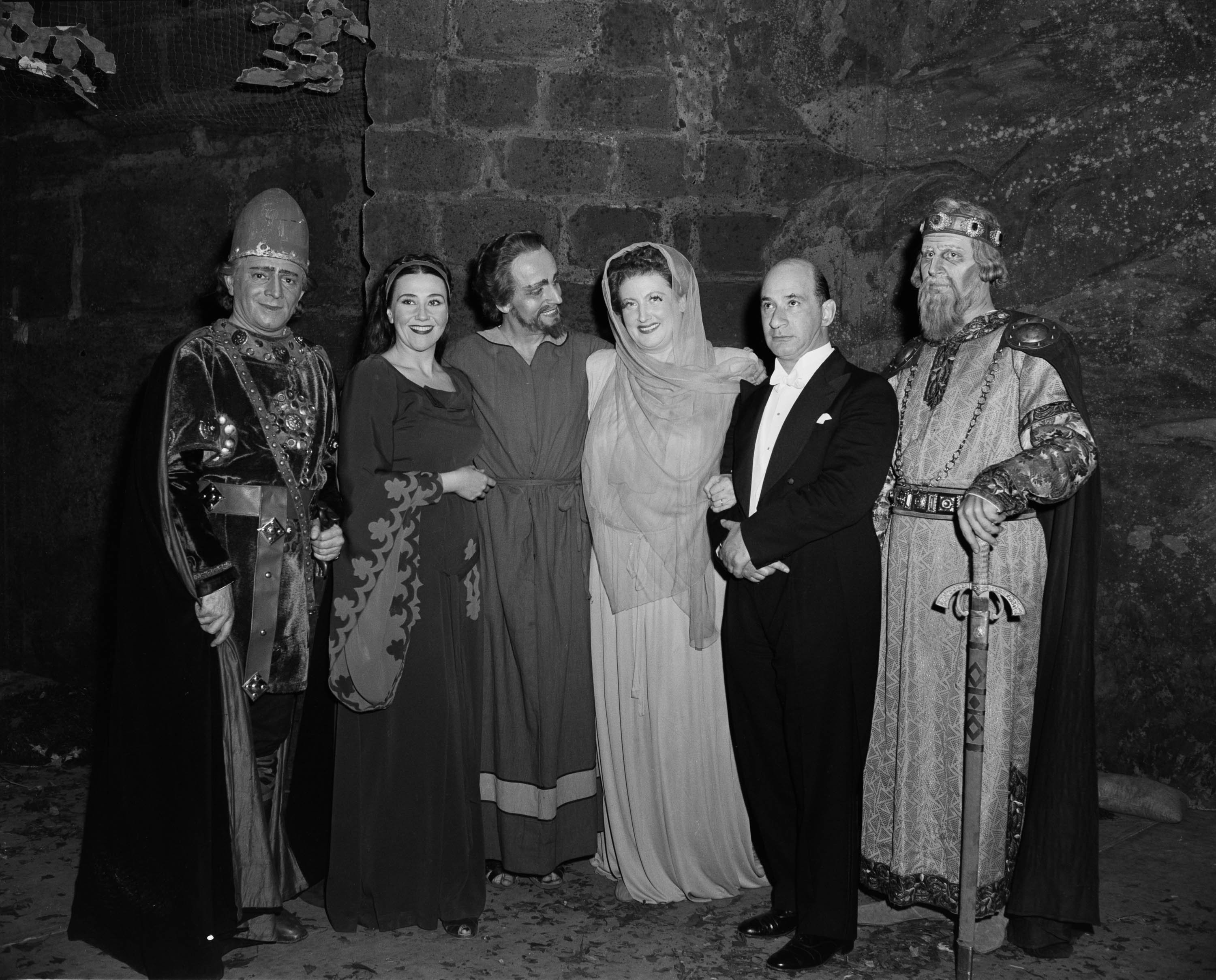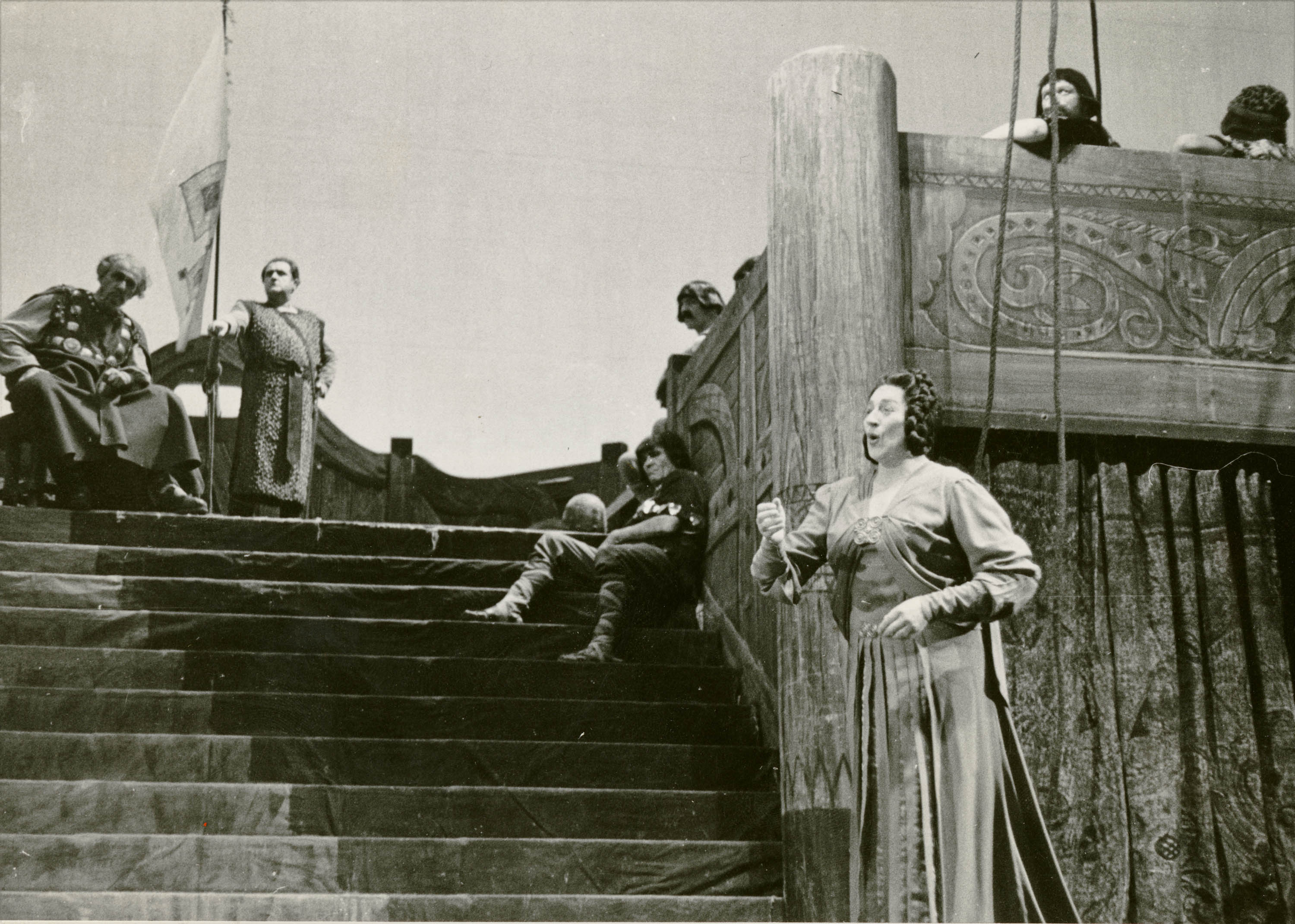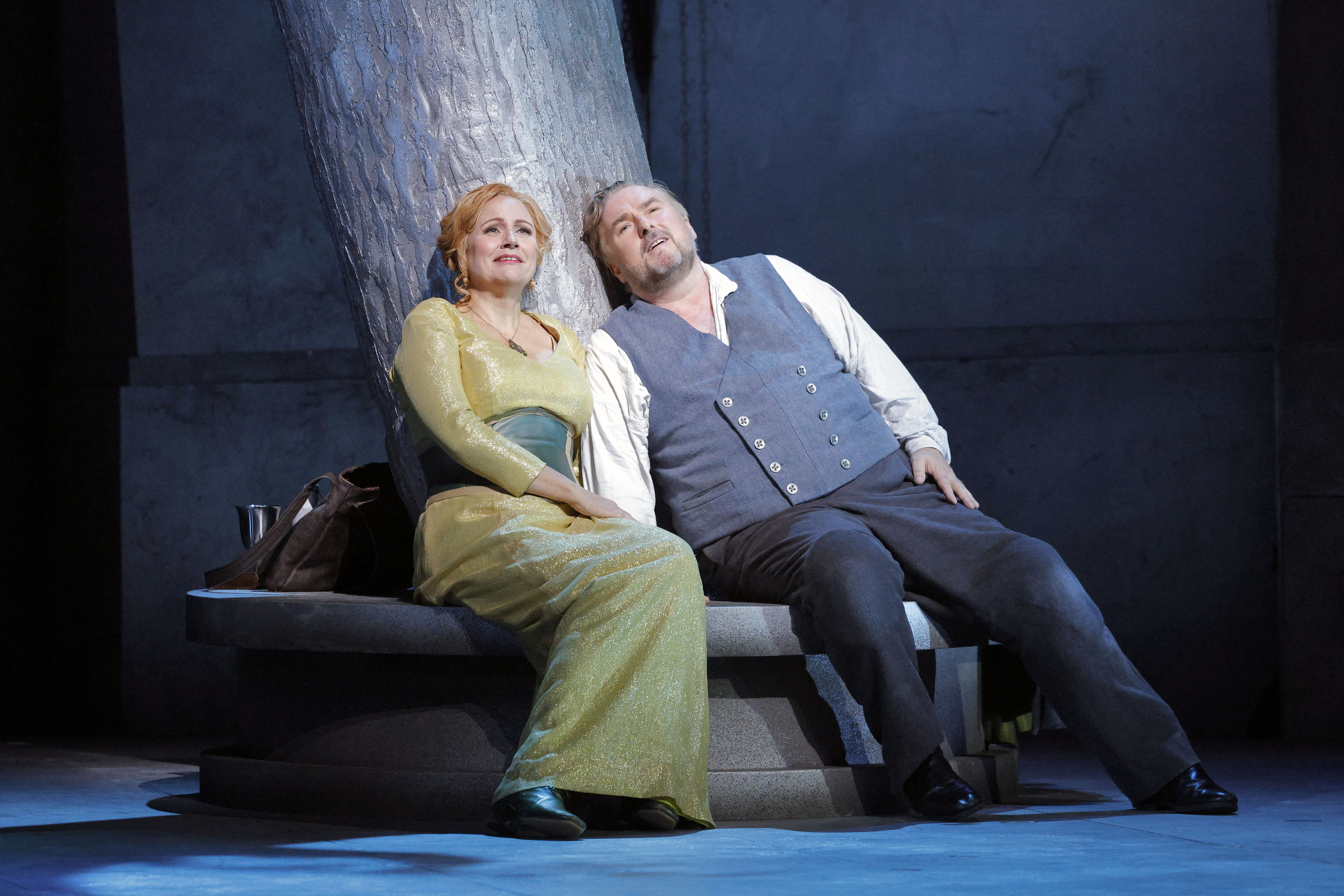Love Duet
TRISTAN AND ISOLDE WAS SAN FRANCISCO OPERA’S FIRST
GERMAN-LANGUAGE OPERA IN 1927, AND IT CONTINUES
TO HOLD A SPECIAL PLACE IN COMPANY HISTORY
BY JEFFERY S. MCMILLAN
1927: Stepping up to the plate
In the early 1920s, San Francisco Opera founder Gaetano Merola was often asked (maybe “pestered” is the word) when his presentations of Italian and French operas would also include the German works of Richard Wagner. Merola coyly responded that he would produce Wagner when the performances would be a credit to his company and to the city of San Francisco. After three artistically ambitious seasons, San Francisco Opera posted a $2,000 profit in 1925. For Merola, the time for Wagner had come: he announced Tristan und Isolde for the 1927 Season.
Tristan was a surprising choice for such a young company. The Wagner operas all pose challenges for their length, orchestral forces, and scenic demands, but Tristanalso requires two singers of a kind that were as uncommon then as they are today. Merola first enlisted San Francisco Symphony Music Director Alfred Hertz, a veteran orchestra leader for Wagner's works, to conduct. He then addressed the mise-en-scèneby hiring Fritz Kraencke, a German designer who had recently moved to America to work in Hollywood. Kraencke was the Berlin State Opera’s head scenic artist and had painted sets for Hanover, Cologne, and the Wagner festival in Bayreuth. Specialist singers Rudolf Laubenthal and Elsa Alsen were brought in to perform the exacting title roles. This artistic core for Tristan, so steeped in the German tradition, all but guaranteed a resounding success for the premiere. Within the next eight seasons, San Francisco Opera added Lohengrin, Die Meistersinger von Nürnberg, Tannhäuser, and the four-opera Ring of the Nibelung cycle to its repertory.
1939: The Orchestra records with two supersingers
The mid- to late-1930s were a golden age for Wagnerian singing in America thanks largely to Norwegian soprano Kirsten Flagstad and Danish tenor Lauritz Melchior. The twosome galvanized operagoers with their thrilling and seemingly inexhaustible voices, making Wagner’s four-hour epics, especially Tristan und Isolde, the hottest ticket in show business. San Francisco Opera  featured the power couple on multiple occasions in 1936, 1937, and 1939, and the Chronicle reported on the duo’s impact on business: “Flagstad plus Wagner equals good business. Melchior plus Wagner equals fair business. Flagstad plus Melchior plus anything—boy, go out and buy a bottle of black ink!”
featured the power couple on multiple occasions in 1936, 1937, and 1939, and the Chronicle reported on the duo’s impact on business: “Flagstad plus Wagner equals good business. Melchior plus Wagner equals fair business. Flagstad plus Melchior plus anything—boy, go out and buy a bottle of black ink!”

Flagstad and Melchior were a box office juggernaut, but, unbeknownst to the public, their personal relationship was mostly acrimonious due to their completely opposite natures. The artists performed together hundreds of times but barely spoke a word to one another offstage. After years of tension, they finally were convinced to forge a less strained partnership in late 1939. Seizing the moment, RCA Victor booked studio time to record them in Los Angeles while they were on tour with San Francisco Opera. Two minutes before the session was set to begin, nerves were on edge as Flagstad sat looking increasingly frustrated because Melchior had not shown up. In the nick of time, the tenor, still dirty and disheveled from an overnight duck hunt, arrived ready to sing. With the musicians of the San Francisco Opera Orchestra accompanying them, opera’s golden duo recorded the Love Duet from Tristan und Isolde, the first of only a handful of commercial recordings they made together.
 Members of the 1947 Tristan und Isolde cast: Walter Olitzki (Melot), Blanche Thebom (Bragane), Set Svanholm (Tristant), Helen Traubel (Isolde), William Steinberg (conductor), Lorenzo Alvary (King Marke). / R. Strohmeyer
Members of the 1947 Tristan und Isolde cast: Walter Olitzki (Melot), Blanche Thebom (Bragane), Set Svanholm (Tristant), Helen Traubel (Isolde), William Steinberg (conductor), Lorenzo Alvary (King Marke). / R. Strohmeyer
1947: A new Isolde in town
In 1941, Kirsten Flagstad returned to occupied Norway to be with her family, leaving a void in the American opera landscape. With opportunity knocking, St. Louis-born soprano Helen Traubel answered the call. Traubel’s unpretentious, downhome-gal persona and huge, radiant voice matched perfectly with Lauritz Melchior, and this Wagner power couple 2.0 were a hit during the war years. Traubel brought her Isolde to San Francisco Opera in 1945, Melchior’s final season with the Company, and two seasons later opposite Swedish tenor Set Svanholm. The stalwart Wagnerian soprano left opera in the early 1950s to sing in night clubs and eventually starred in Hollywood comedies.

1949: Merola stands by Flagstad
Kirsten Flagstad’s reentry into American operatic life was dogged by a misinformation campaign of lies and innuendos about her conduct during the war perpetuated by, among others, the powerful gossip columnist Walter Winchell. As a result, Flagstad’s recital at Carnegie Hall in April 1947 drew pickets bearing signs like “Let freedom sing, not Flagstad.” Two days later, her recital at the Philadelphia Academy of Music was interrupted by paid hecklers and stink bombs. Flagstad refused to be intimidated. “I’m not a bit afraid,” she said. “I’ve done nothing wrong, and I’m not going to let them win, whoever they are.” While incidents at her recitals quickly receded, the attempts to “cancel” her had a chilling effect on her opera engagements.
Gaetano Merola was among the first to welcome Flagstad back to the American opera stage, announcing her for his 1949 Season. Fearing potential controversy, the War Memorial trustees voted to officially “disapprove” of the engagement which prompted Merola to declare: “No Flagstad, no season.” Letters flooded in and editorials were published in support of the soprano until the protest vote was reversed. Alfred Frankenstein wrote about her September 30 return as Isolde in the Chronicle: “No ‘Tristan’ in local history seemed so intense, so totally absorbing, so completely overwhelming in its impact … Nothing has happened to dim Flagstad’s luster as the supreme Wagnerian soprano of our time … Her voice remains an instrument of incomparable golden glory.”
 Ludwig Suthaus as Tristan (holding the flag) and Margarete Klose as Brangäne, 1953 / Skelton Studios
Ludwig Suthaus as Tristan (holding the flag) and Margarete Klose as Brangäne, 1953 / Skelton Studios
1953: US debuts of Experienced Wagnerians Two weeks before the opening of the 1953 Season, Gaetano Merola collapsed and died while conducting a concert at Stern Grove. Without its founder and leader of 30 years, San Francisco Opera rallied to present a season filled with marquee works like Boito’s Mefistofele, Strauss’ Elektra, Puccini’s Turandot, Mussorgsky’s Boris Godunov, Verdi’s Un Ballo in Maschera, and Tristan und Isolde. The San Francisco Examiner review of Tristanopened with a reprimand of the audience. “Will they never learn that an opera doesn’t end until the curtain is all down and the orchestra has played its very last tones as a sort of cadence or commentary or benediction on all that has come before.” Critic Alexander Fried might have cut San Francisco a little slack for applauding too soon. They had just witnessed extraordinary proof that a new generation had risen to succeed the legends of the recent past and a new chapter for the Company was decidedly underway. Appearing in their first seasons in America, soprano Gertrude Grob-Prandl, tenor Ludwig Suthaus, mezzo-soprano Margarete Klose, and conductor Georg Solti created a Tristan und Isolde experience that bordered on the sacred. Solti, still a young firebrand and not yet the paragon of opera and symphonic conducting he would become, earned Fried’s praises along with another scolding. “He must learn that a conductor who excitedly stamps his foot on the podium simply adds a loud and superfluous drum part to the composer’s original music.”
Two weeks before the opening of the 1953 Season, Gaetano Merola collapsed and died while conducting a concert at Stern Grove. Without its founder and leader of 30 years, San Francisco Opera rallied to present a season filled with marquee works like Boito’s Mefistofele, Strauss’ Elektra, Puccini’s Turandot, Mussorgsky’s Boris Godunov, Verdi’s Un Ballo in Maschera, and Tristan und Isolde. The San Francisco Examiner review of Tristanopened with a reprimand of the audience. “Will they never learn that an opera doesn’t end until the curtain is all down and the orchestra has played its very last tones as a sort of cadence or commentary or benediction on all that has come before.” Critic Alexander Fried might have cut San Francisco a little slack for applauding too soon. They had just witnessed extraordinary proof that a new generation had risen to succeed the legends of the recent past and a new chapter for the Company was decidedly underway. Appearing in their first seasons in America, soprano Gertrude Grob-Prandl, tenor Ludwig Suthaus, mezzo-soprano Margarete Klose, and conductor Georg Solti created a Tristan und Isolde experience that bordered on the sacred. Solti, still a young firebrand and not yet the paragon of opera and symphonic conducting he would become, earned Fried’s praises along with another scolding. “He must learn that a conductor who excitedly stamps his foot on the podium simply adds a loud and superfluous drum part to the composer’s original music.”

1967–1972: When heldentenor giants walked the Earth in San Francisco
While pursuing an MA in psychology at Stanford University, Jess Thomas abruptly decided to change careers and become an opera singer. His 1957 operatic debut with San Francisco Opera was quickly followed by a series of international triumphs that pointed him toward the heavy Wagner roles. In 1967, already one of the leading heldentenors of his generation, Thomas made his role debut as Tristan in San Francisco Opera’s new production. The Oakland Tribune’s Paul Hertelendy remarked, “There had been question whether the honey-voiced tenor Jess Thomas could sing such a big role as Tristan. He sang it to perfection … In case he was not quite the world’s leading Wagnerian tenor yesterday morning, he is that today without any question.” Thomas reprised the role for San Francisco in 1974, sharing the stage with one of the century’s greatest Isoldes, Birgit Nilsson.
By the 1970s, Wolfgang Windgassen, who had emerged on the operatic scene in 1951, was the living gold standard for Wagner performance in Europe. American audiences had to be content with the German tenor’s records because Windgassen had only visited the United States once, in 1957, to sing the Ring operas at the Metropolitan Opera. Nearing retirement in 1970, the esteemed mastersinger surprised everyone when he accepted San Francisco Opera General Director Kurt Herbert Adler’s invitation to sing Tristan on short notice (tenor Jon Vickers had canceled during rehearsals). The chivalrous Windgassen quickly boarded a flight from Germany; he simply could not let a great artist like Birgit Nilsson sing the Tristan duets by herself! Through five legendary performances, Windgassen and Nilsson gave San Franciscans a taste of the new, modern paradigm for singing Wagner where, according to Martin Bernheimer, great voices “had to be at the command of singers with brains, singers with a sense of poetry, singers capable of deep psychological insights, singers able to project maximal character and mood with minimal movement and gesture. Wolfgang Windgassen was the very model of such a singer” (Los Angeles Times).
In 1972, Lauritz Melchior returned to San Francisco Opera for the Company’s 50th anniversary celebrations. In one of his final public appearances, the tenor conducted the Orchestra in a waltz number at Stern Grove, signed hundreds of autographs, and regaled patrons with tales from the old days. He died a few months later, a day shy of his 83rd birthday.
1980: A royal lineage
Along with its inimitable roster of interpreters for the title roles, San Francisco Opera’s honor roll of King Markes is also impressive. In 1980, the American bass-baritone Simon Estes added his name to the royal line that included Emanuel List, Alexander Kipnis, and Kurt Moll. Estes had recently starred in Der Fliegende Holländer at Bayreuth, becoming the first male African American artist to appear at the Festival. The newly minted Wagnerian, who had performed in La Bohème, Aida, and other works with San Francisco Opera since 1967, brought his acclaimed portrayal of the Dutchman to San Francisco in 1979 and King Marke the following season. As Marke, Estes “… invested the monologue of the betrayed monarch with rolling bel-canto tones, even in scale, poignant in inflection, sympathetic in expression” (Los Angeles Times).

2006: An unforgettable fairy-tale presentation
Former San Francisco Opera Music Director Donald Runnicles has led many of Wagner’s music dramas in the War Memorial Opera House, including Tristan in 1998 and 2006. Maestro Runnicles’ conducting of the latter, presented in David Hockney’s fairy-tale production, prompted Georgia Rowe of the Oakland Tribune to say “… the vitality, the expansiveness, the lush Romanticism of his approach Thursday amounted to something truly unforgettable.” The Isolde of soprano Christine Brewer, a frequent Runnicles collaborator, impressed the Chronicle’s Joshua Kosman: “she sounded as fresh and tireless in the concluding ‘Liebestod’ as she had in the extended narrative of Act 1.”
2024: Tristan sails back into the Bay Area
This season, Caroline H. Hume Music Director Eun Sun Kim leads her first performances of Tristan und Isolde in the new-to-San Francisco Opera production by director Paul Curran. Anja Kampe, who made her Company debut as Sieglinde in the 2011 Ring cycle, is Isolde and renowned heldentenor Simon O’Neill takes on Tristan, Kwangchul Youn is the King, and Wolfgang Koch and Annika Schlicht make their Company debuts as Kurwenal and Brangäne, respectively.
 Anja Kampe and Simon O’Neill in the title roles of Tristan und Isolde, 2024. / Cory Weaver
Anja Kampe and Simon O’Neill in the title roles of Tristan und Isolde, 2024. / Cory Weaver
Public Relations Director Jeffery S. McMIllan is a writer on opera and jazz. He is the author of Delightfulee: The Life and Music of Lee Morgan and a repeat guest on the Metropolitan Opera’s broadcast Opera Quiz.

